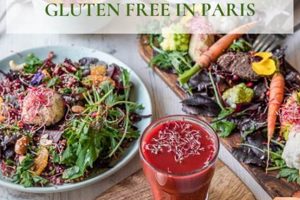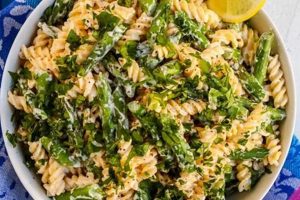The combination of dietary restrictions omitting both grains and animal-derived products, while simulating oceanic cuisine, presents a unique challenge in culinary arts. This involves utilizing plant-based ingredients such as vegetables, legumes, nuts, seeds, and sea vegetables to recreate the textures and flavors typically associated with fish and shellfish, all while adhering to a grain-free protocol. An example would be using hearts of palm to mimic the flaky texture of fish in a vegan ceviche, served alongside cauliflower rice.
This approach to food preparation caters to individuals with specific dietary needs and preferences, including those with gluten sensitivities, allergies, or ethical commitments to veganism. The focus on plant-based alternatives encourages creativity in the kitchen, leading to nutrient-rich meals. Historically, vegan cuisine has focused primarily on terrestrial plants. The recent surge in interest in recreating seafood dishes from plant-based sources broadens the scope of vegan cooking and introduces new techniques and ingredients.
The following sections will delve into the key aspects of crafting dishes that meet the criteria of being both grain-free and vegan, while evoking the essence of seafood. This includes exploring suitable plant-based protein sources, flavor enhancers, and techniques for achieving desired textures and visual appeal.
Tips for Grain-Free Vegan Seafood Recipes
Crafting dishes which emulate ocean-derived cuisine while adhering to both grain-free and vegan guidelines requires careful attention to ingredient selection and preparation techniques. The following tips aim to guide the successful creation of such meals.
Tip 1: Leverage Sea Vegetables: Incorporate nori, kelp, dulse, or sea beans to impart authentic oceanic flavors and mineral content. Nori sheets can be used to wrap plant-based sushi or crumbled into vegan fish alternatives.
Tip 2: Master the Art of Plant-Based Textures: Experiment with ingredients like hearts of palm (for “fish” flakes), konjac root (for “shrimp”), or jackfruit (for a shredded “crab” analogue). Proper preparation is key to achieving desired textures.
Tip 3: Utilize Umami-Rich Ingredients: Enhance depth of flavor with ingredients like mushrooms, sun-dried tomatoes, miso paste, or nutritional yeast. These provide savory notes that mimic the complexities of seafood.
Tip 4: Exploit Citrus and Aromatics: Fresh lemon, lime, and herbs such as dill, parsley, and cilantro are essential for brightening and complementing the flavors of vegan seafood dishes. Zest adds an aromatic dimension.
Tip 5: Consider Smoky Flavors: Smoked paprika, liquid smoke, or smoked salt can add a subtle, smoky undertone reminiscent of grilled or smoked seafood. Use sparingly to avoid overpowering other flavors.
Tip 6: Explore Grain-Free Breading and Coatings: Utilize almond flour, coconut flour, or finely ground seeds to create crispy breadings for vegan “fish” fillets or “scallops.” Ensure proper binding with egg replacers like flaxseed meal or aquafaba.
Tip 7: Don’t Underestimate Marinades: Marinades help infuse plant-based ingredients with flavor and improve texture. A marinade of soy sauce, ginger, garlic, and seaweed flakes can elevate the taste of tofu or tempeh before cooking.
These tips emphasize the importance of utilizing a diverse range of ingredients and techniques to create meals that are both grain-free and vegan, while still capturing the essence of seafood flavors and textures. This approach caters to specific dietary needs while encouraging culinary creativity and exploration.
Moving forward, the article will explore specific recipe examples to illustrate the practical application of these tips and further guide the creation of delicious and satisfying grain-free vegan seafood meals.
1. Plant-based protein sources
Plant-based protein sources are fundamental to replicating the nutritional profile and textural characteristics of seafood in grain-free vegan cuisine. Their careful selection and preparation are critical for developing satisfying and nutritionally complete meals that adhere to both dietary restrictions.
- Tofu and Tempeh Transformation
Tofu and tempeh, derived from soybeans, serve as versatile protein bases. Their relatively neutral flavor allows for absorption of marine-inspired seasonings. Pressing tofu removes excess moisture, enhancing its ability to mimic the firm texture of certain fish. Tempeh, with its chewier texture, can be marinated and crumbled to resemble crab or lobster meat. Proper preparation techniques, such as marinating in seaweed-infused broths, are essential for achieving authentic flavors.
- Legume-Based Imitations
Chickpeas and lentils, while typically associated with terrestrial dishes, can be creatively employed. Chickpea flour (besan) can form the base of grain-free batters for vegan “fish” and “chips.” Lentils, when properly seasoned and processed, can mimic the texture of ground seafood in preparations like vegan fish cakes. The inherent earthiness of legumes requires careful balancing with oceanic flavors.
- Hearts of Palm as Seafood Substitute
Hearts of palm, harvested from the inner core of certain palm trees, possess a naturally flaky texture reminiscent of white fish. This texture makes them a suitable ingredient for creating vegan ceviche or fish tacos. Marinating hearts of palm in citrus juices and seaweed extracts enhances their flavor and further amplifies the seafood illusion. They are low in calories and provide some dietary fiber.
- Seitan as a Protein Option
Seitan, composed of wheat gluten, is typically excluded from grain-free diets. However, its firm, chewy texture makes it a plausible vegan seafood substitute for those who are not following a grain-free diet, only vegan. It can be molded and seasoned to replicate the texture of calamari or scallops. Marination and careful cooking are essential for achieving optimal texture and palatability. As a source of protein, seitan can contribute to a balanced nutritional profile within a vegan seafood dish.
The skillful application of plant-based proteins, combined with appropriate seasonings and culinary techniques, facilitates the creation of convincing and nutritious grain-free vegan seafood dishes. The selection of protein source depends on desired texture and flavour profile. This is integral for replicating traditional seafood fare.
2. Sea vegetable utilization
Sea vegetable utilization is paramount in crafting authentic and nutritionally complete grain-free vegan seafood recipes. The incorporation of sea vegetables directly addresses the absence of animal-derived seafood, providing the characteristic oceanic flavors and essential nutrients often lacking in purely terrestrial plant-based diets. This is a direct cause-and-effect relationship; without sea vegetables, the sensory experience and nutritional value of the dish are diminished. Real-world examples include the use of nori seaweed to impart a fishy taste to tofu-based sushi or the inclusion of dulse flakes in vegan “fish” cakes to mimic the flavor and appearance of seafood.
The practical significance of understanding the connection lies in the ability to create more convincing and satisfying vegan seafood alternatives. The utilization of sea vegetables extends beyond mere flavor enhancement; they contribute vital minerals such as iodine, crucial for thyroid function, and other trace elements often scarce in land-based vegan diets. Kelp noodles, for example, can replace traditional pasta in seafood-style dishes, providing a grain-free base rich in minerals and fiber. Furthermore, the incorporation of sea vegetables offers textural variety, ranging from the crispy texture of toasted nori to the chewy consistency of wakame.
In conclusion, sea vegetable utilization is not merely a stylistic choice but a functional necessity in the development of grain-free vegan seafood recipes. Challenges may include sourcing high-quality, sustainably harvested sea vegetables and educating consumers on their nutritional benefits. A comprehensive understanding of their flavor profiles and textures allows for their strategic integration, effectively bridging the gap between the culinary limitations of a grain-free vegan diet and the desired sensory experience of seafood dishes.
3. Umami flavor enhancement
Umami, often described as a savory or meaty flavor, plays a critical role in replicating the complex taste profiles associated with seafood, particularly within the context of grain-free vegan cuisine. The strategic enhancement of umami is therefore essential in developing palatable and satisfying recipes that adhere to these specific dietary constraints.
- Mushroom Incorporation
Mushrooms, particularly dried varieties such as shiitake, are potent sources of umami. Their inclusion in broths, sauces, or as direct ingredients contributes significantly to the depth of flavor. For example, soaking dried shiitake mushrooms releases glutamates, which can then be used as a flavorful base for vegan seafood bisques or stews. This replicates the rich, savory notes found in traditional seafood dishes.
- Seaweed Derivatives
Seaweeds, beyond their inherent marine flavors, are also rich in glutamates. Kombu, for instance, is frequently used in Japanese cuisine to create dashi, a savory broth. In grain-free vegan seafood recipes, kombu can be infused into cooking liquids or ground into powders to enhance umami. Nori seaweed, often used in sushi, can also be toasted and crumbled to add a concentrated umami flavor to plant-based seafood alternatives.
- Fermented Ingredients
Fermented ingredients, such as miso paste and soy sauce (tamari for gluten-free options), are valuable tools for umami enhancement. Miso paste, made from fermented soybeans, contributes a complex savory flavor that can mimic the depth of flavor found in seafood stocks. Tamari provides a salty umami note that can enhance marinades and sauces for vegan “fish” preparations.
- Nutritional Yeast Utilization
Nutritional yeast, an inactive form of yeast, offers a cheesy, nutty flavor that also imparts umami. It is frequently used in vegan cuisine to add savory notes to sauces and toppings. In the context of grain-free vegan seafood recipes, nutritional yeast can be incorporated into vegan “crab” cakes or sprinkled over plant-based “fish” fillets to enhance their overall flavor profile.
The selective application of umami-rich ingredients is not merely about adding flavor, but about constructing a holistic sensory experience that mirrors the complexities of traditional seafood dishes. This is particularly crucial in grain-free vegan cuisine, where the inherent flavors of plant-based ingredients must be strategically manipulated to compensate for the absence of animal products and grains. The skillful utilization of mushrooms, seaweeds, fermented products, and nutritional yeast allows for the creation of compelling and satisfying alternatives.
4. Grain-free binding agents
Grain-free binding agents are essential components in developing cohesive and palatable grain-free vegan seafood recipes. Their function is to provide structure and prevent the disintegration of ingredients, particularly in preparations that mimic the texture and form of traditional seafood dishes. The absence of gluten, a common binding agent in conventional cooking, necessitates the use of alternative substances to achieve desired results. The successful implementation of grain-free binding agents directly influences the overall texture and mouthfeel of the final product. For example, without an effective binding agent, vegan “crab” cakes may crumble and lack the firm consistency expected of the dish.
Common grain-free binding agents include tapioca starch, arrowroot powder, potato starch, and flaxseed meal. Tapioca and arrowroot starches contribute to a light and somewhat elastic texture, suitable for vegan “fish” fillets or coatings. Potato starch offers a slightly denser texture, often used in vegan “scallops” or “shrimp.” Flaxseed meal, when combined with water, forms a gel that acts as a binding agent while also providing added nutritional value. Real-world examples can be seen in recipes employing a combination of chickpea flour and tapioca starch to create a batter for vegan “fish” and chips, achieving a crispy exterior and a cohesive interior. The practical significance lies in the ability to create familiar dishes that meet specific dietary requirements without compromising on texture or flavor.
In conclusion, grain-free binding agents are indispensable elements in the successful execution of grain-free vegan seafood recipes. They bridge the gap between conventional seafood dishes and their plant-based, grain-free counterparts, allowing for the creation of cohesive, flavorful, and texturally appropriate alternatives. Challenges may include achieving the correct balance of binding agents to avoid undesirable textures, such as excessive gumminess or dryness. Understanding the properties of each binding agent and its interaction with other ingredients is key to achieving optimal results.
5. Mimicking seafood texture
The successful creation of grain-free vegan seafood recipes hinges significantly on the accurate replication of seafood textures using plant-based ingredients. This aspect is not merely cosmetic; texture is an integral component of the overall sensory experience and contributes substantially to the perceived authenticity of the dish. The absence of animal products and grains necessitates the resourceful application of plant-based materials to emulate the characteristic flakiness, chewiness, or tenderness associated with various types of seafood. Without appropriate textural mimicry, the dish may fail to deliver the expected culinary satisfaction, despite accurate flavor profiles.
One practical example involves the use of hearts of palm to simulate the flaky texture of white fish. When marinated in lemon juice and seaweed extracts, hearts of palm can effectively replicate the mouthfeel of cod or haddock in vegan ceviche or fish tacos. Similarly, konjac root, often processed into “shirataki” noodles or blocks, can be manipulated to resemble the firm, slightly rubbery texture of calamari or shrimp. Jackfruit, particularly when young and green, possesses a fibrous texture that, when properly seasoned and prepared, can mimic pulled crab or lobster meat. The strategic manipulation of these plant-based ingredients requires an understanding of their inherent properties and the application of appropriate cooking techniques to achieve the desired textural outcome. This requires consideration of moisture content, fiber alignment, and the effects of heat on these materials.
In conclusion, mimicking seafood texture is not merely a culinary embellishment but a functional requirement in the development of convincing grain-free vegan seafood recipes. Overcoming challenges associated with replicating diverse seafood textures requires experimentation, ingredient knowledge, and a willingness to adapt traditional cooking methods to suit plant-based materials. The careful attention to textural detail elevates the dining experience, bridging the gap between dietary restrictions and culinary expectations.
6. Citrus & herb balance
The successful emulation of seafood flavors in grain-free vegan cuisine relies heavily on a precise equilibrium between citrus elements and herbaceous notes. This balance is not merely additive but synergistic, creating a flavor profile that mimics the freshness and complexity associated with oceanic fare. The effect of acidity from citrus, such as lemon or lime, cuts through the richness of plant-based fats and proteins, while the aromatic compounds in herbs contribute layered dimensions of flavor. Without this careful orchestration, the resulting dish may lack the characteristic brightness and vibrancy expected of seafood preparations.
Consider, for example, a vegan ceviche utilizing hearts of palm as a substitute for fish. The application of lime juice not only “cooks” the hearts of palm by denaturing their proteins, similar to the effect on raw fish, but also provides a crucial acidic counterpoint to their mild flavor. The addition of cilantro, with its bright and slightly peppery notes, further enhances the perceived freshness. Conversely, a vegan “crab” cake made from jackfruit benefits from the addition of lemon zest and dill, which contribute brightness and complement the savory flavor of the jackfruit. The practical implication of this understanding is the ability to transform relatively neutral plant-based ingredients into compelling seafood alternatives through strategic flavor manipulation. Failure to achieve this balance can result in dishes that are either too bland or overly dominated by the inherent flavors of the substitute ingredients.
In conclusion, the artful manipulation of citrus and herb pairings is an indispensable skill in crafting grain-free vegan seafood recipes. The ability to effectively balance these flavor components allows for the creation of dishes that are not only palatable but also convincingly reminiscent of traditional seafood preparations. Challenges may include sourcing high-quality herbs and accurately gauging the acidity levels of different citrus fruits. Mastering this balance is key to elevating the dining experience and bridging the gap between dietary restrictions and culinary expectations.
7. Smoky flavor integration
The incorporation of smoky flavors within grain-free vegan seafood recipes represents a strategic approach to replicating the sensory characteristics of traditionally smoked or grilled seafood. This technique serves to enhance the perceived authenticity and complexity of plant-based dishes designed to mimic the taste and aroma profiles of ocean-derived cuisine.
- Smoked Paprika Application
Smoked paprika, derived from dried and smoked peppers, provides a readily accessible method for imparting a subtle smoky note. Its application in spice rubs for vegan “fish” fillets or as an ingredient in vegan “seafood” sauces contributes to a depth of flavor that mimics slow-smoked preparations. The intensity can be adjusted based on the specific variety of smoked paprika used, ranging from sweet to hot.
- Liquid Smoke Utilization
Liquid smoke, a concentrated flavoring derived from the condensation of wood smoke, offers a more pronounced smoky impact. Its careful application is crucial, as overutilization can result in an artificial or acrid taste. Diluted in marinades or brushed onto plant-based “seafood” alternatives prior to cooking, it contributes a characteristic smoky aroma and flavor.
- Smoked Salt Incorporation
Smoked salt, produced by cold-smoking salt crystals, provides a nuanced smoky element that enhances both flavor and aroma. Its use as a finishing salt on vegan “scallops” or sprinkled into vegan “crab” cakes adds a subtle smoky undertone that complements other flavor components without overpowering them. The type of wood used for smoking the salt (e.g., hickory, applewood) influences the final flavor profile.
- Smoking Techniques with Wood Chips
The most authentic method involves actual smoking techniques, using wood chips (such as hickory, mesquite, or applewood) in a smoker or grill. This method requires specialized equipment and precise temperature control to avoid overcooking the plant-based ingredients. Tofu or tempeh, for example, can be cold-smoked to impart a deep, penetrating smoky flavor, mimicking the qualities of traditionally smoked fish.
The successful integration of smoky flavors into grain-free vegan seafood recipes hinges on a balanced approach, avoiding overpowering the more delicate flavors of the plant-based ingredients. The choice of smoky flavoring agent and its method of application significantly influence the final culinary outcome, contributing to the overall sensory experience of the dish.
Frequently Asked Questions
This section addresses common inquiries regarding the creation and consumption of grain-free vegan seafood recipes, providing clear and concise answers to ensure a comprehensive understanding.
Question 1: What are the primary challenges in developing grain-free vegan seafood recipes?
The principal challenge lies in replicating the texture and flavor profiles of traditional seafood dishes using only plant-based ingredients that adhere to grain-free restrictions. This requires innovative use of plant proteins, sea vegetables, and flavor enhancers.
Question 2: What are suitable grain-free alternatives for breading or battering vegan seafood?
Acceptable alternatives include almond flour, coconut flour, finely ground seeds (such as flax or sunflower seeds), and various starches like tapioca or arrowroot. These can be used individually or in combination to achieve desired textures.
Question 3: How can umami flavors be effectively incorporated into grain-free vegan seafood dishes?
Umami can be enhanced through the use of ingredients such as mushrooms (especially dried shiitake), seaweeds (kombu, nori), fermented products (miso, tamari), and nutritional yeast. These contribute savory notes that mimic the complexity of seafood.
Question 4: Are grain-free vegan seafood recipes nutritionally complete?
Nutritional completeness depends on careful ingredient selection. Emphasis should be placed on incorporating protein sources, essential fatty acids (from flax or chia seeds), and nutrients often found in seafood, such as iodine (from sea vegetables) and vitamin B12 (through supplementation or fortified foods).
Question 5: How can the “fishy” taste be replicated in vegan seafood recipes?
The characteristic flavor can be achieved through the strategic use of sea vegetables, particularly nori, kelp, and dulse. These can be incorporated directly into dishes or used to create infused oils or broths.
Question 6: What are some common misconceptions about grain-free vegan seafood?
A common misconception is that these recipes are inherently bland or unsatisfying. With proper techniques and ingredient selection, grain-free vegan seafood dishes can be flavorful, texturally diverse, and nutritionally adequate. Another misconception is that only expensive ingredients are suitable. Economical ingredients like tofu and lentils can produce good results.
The information provided serves as a foundation for understanding the complexities and possibilities within the realm of grain-free vegan seafood cuisine.
The subsequent section will provide example recipes, demonstrating the practical application of the principles discussed.
Grain Free Vegan Seafood Recipes
The preceding exploration details the intricate process of crafting dishes which replicate the essence of seafood within the constraints of a grain-free vegan dietary framework. Key components involve strategic utilization of plant-based proteins, sea vegetables, umami enhancers, and grain-free binding agents, coupled with careful attention to texture and flavor balance. Success in this culinary domain hinges on a thorough understanding of ingredient properties and the application of innovative cooking techniques.
The future development of grain-free vegan seafood recipes necessitates continued experimentation and refinement of plant-based alternatives. Attention should be directed toward improving nutritional profiles and exploring sustainable ingredient sourcing. Ultimately, the pursuit of these recipes expands culinary boundaries, creating inclusive options for diverse dietary needs and preferences. The commitment to innovation remains essential to realizing the full potential of this culinary synthesis.







